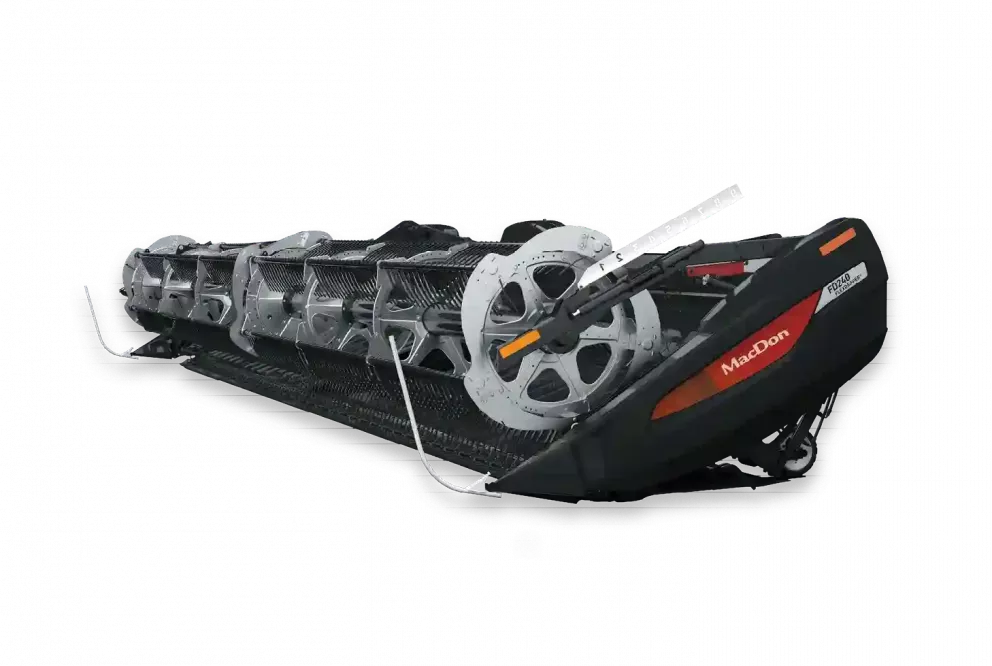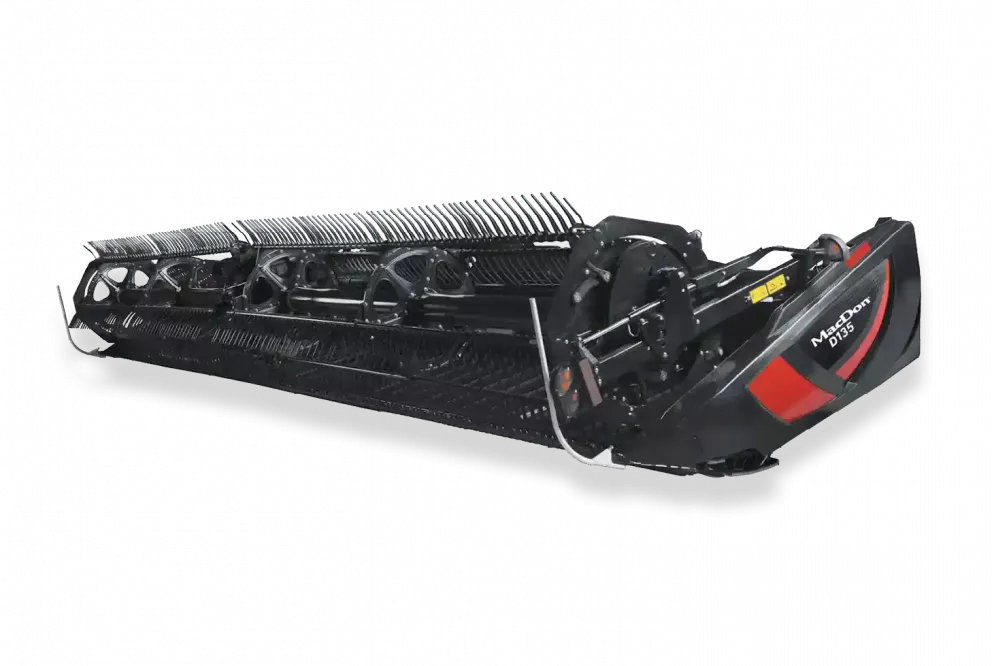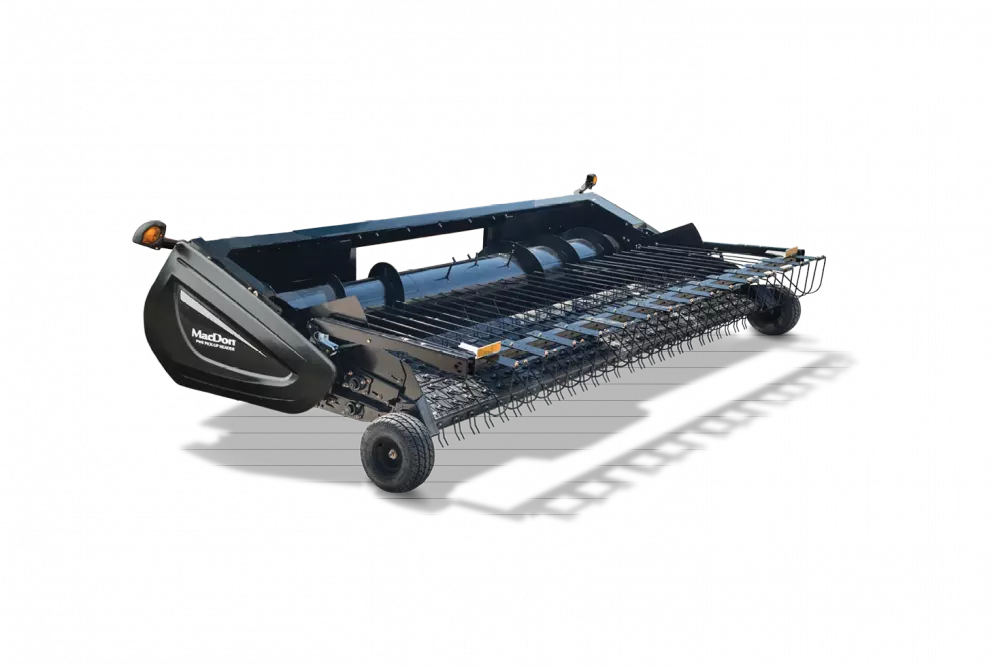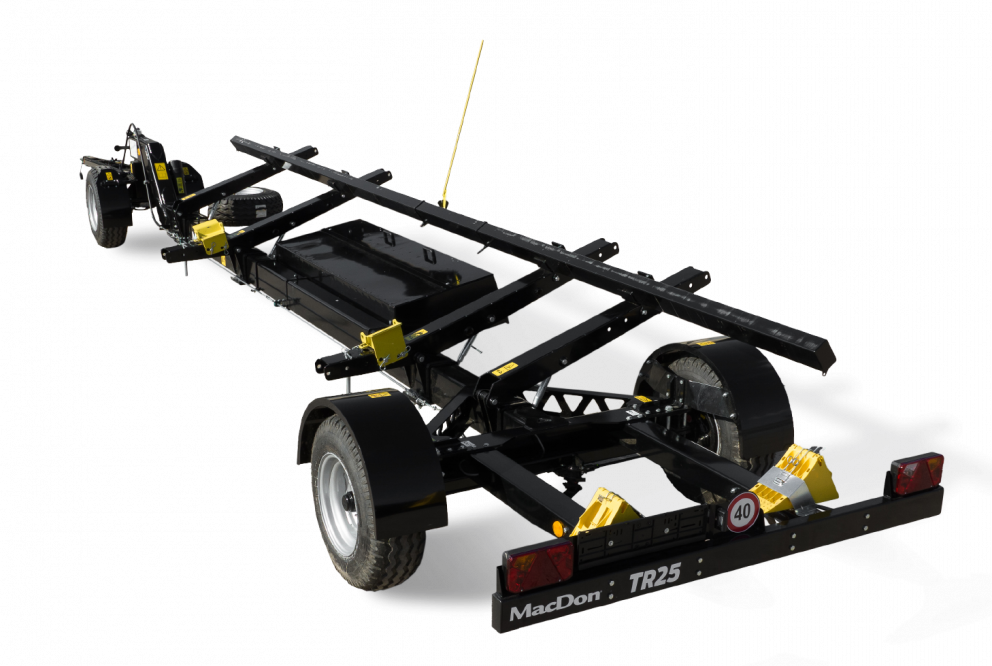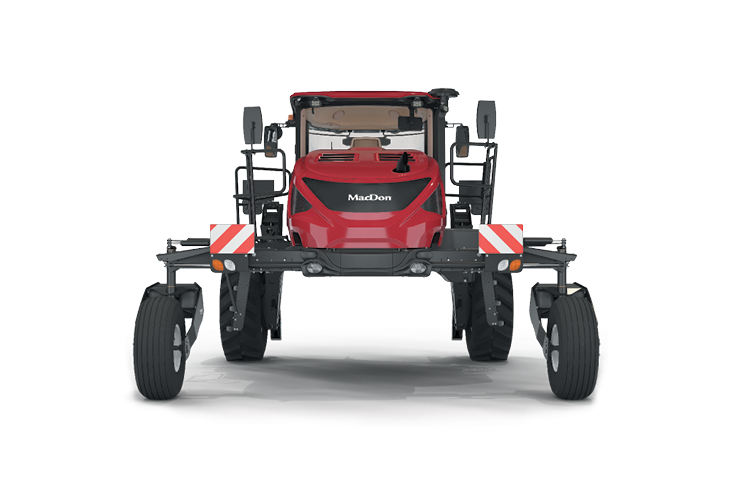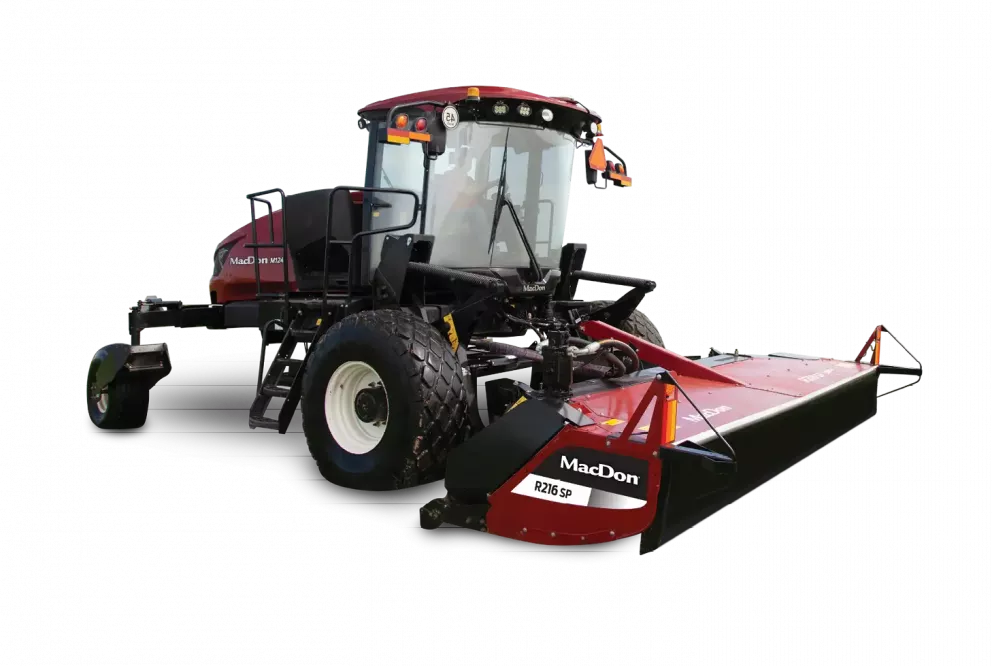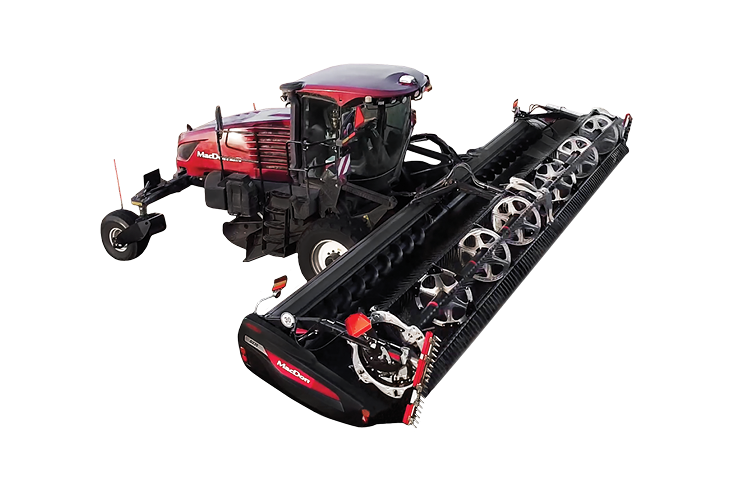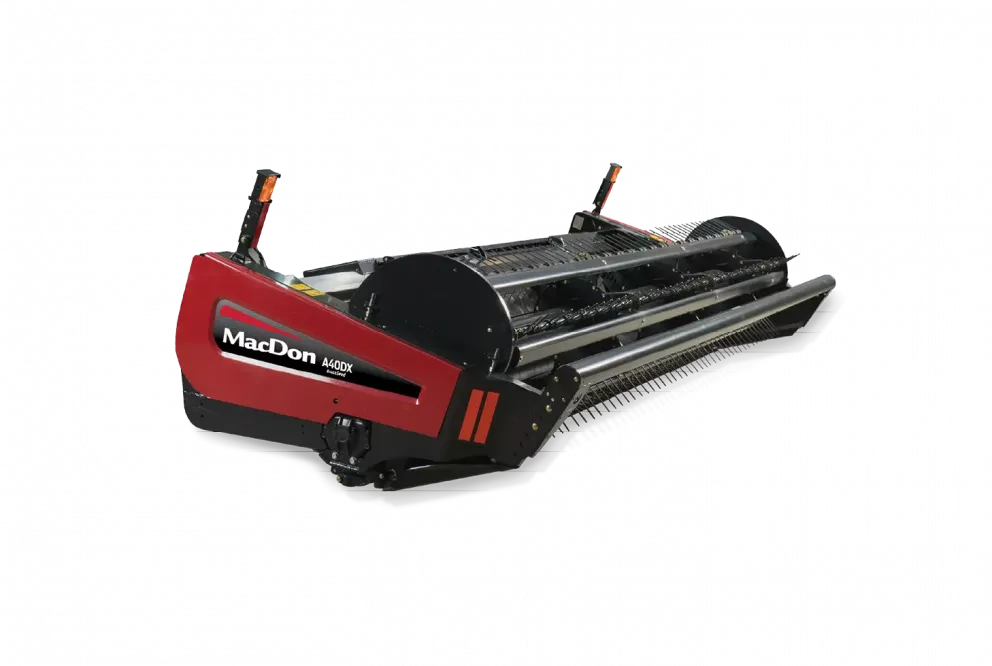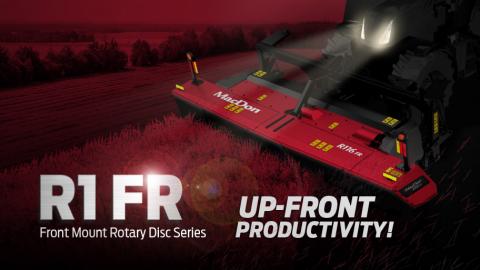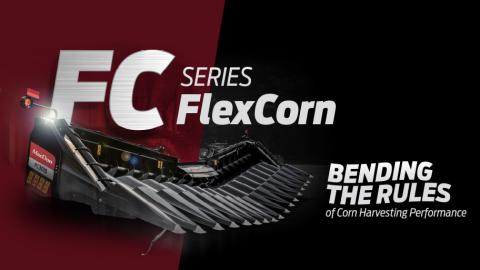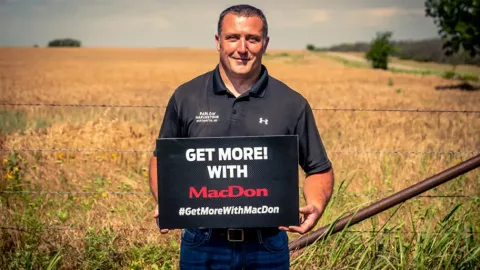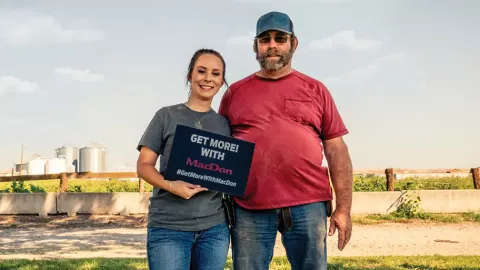Family Road-Trip
For the Thouvenels, custom cutting is truly a family affair.
GOING TO MACDON’S DRAPER WAS JUST NIGHT AND DAY. THE DIFFERENCE WAS NOTICEABLE IN WHEAT, BUT EVEN MORE SO IN SOYBEANS.
Custom harvesters are, by definition, confident people. After all, if your livelihood depends on being able to cut any crop no matter how bad the conditions, it helps to have a little faith that things are going to work out in your favor. Two people who exemplify that type of positive attitude are Garrett and Aubree Thouvenel, a husband and wife team that see it as no big deal to take on the rigors of each year’s harvest with their two young daughters in tow.
The Thouvenels have had their daughters travelling with them – Maycee (9) and Jaydee (4) – since they were infants, bringing a whole new meaning to the words family business.
“They really don’t know any other life than being on the road with us,” said Aubree when Performance Magazine caught up with the Thouvenels mid-way through the fall soybean harvest near Grant, Nebraska. “They are just used to coming along wherever we go, so they are pretty laid back about it all.”
The girls’ take-it-as-it-comes attitude is a mirror image of that which has been exhibited by their parents since the very start of their 20 year career as custom harvesters. Back in the mid 90s, when the Thouvenels went on their first harvest, they certainly didn’t foresee it as something that they would still be doing two decades later. Neither of them come from a harvesting background; Aubree was not from a farm, and Garrett’s dad was a lineman for the local electrical cooperative. Garrett’s primary contact with agriculture was through raising cattle near his hometown in Versailles, Missouri, something he had been doing on his own since his youth.
“I started buying steers when I was 10 or 11 years old and my little operation grew,” said Garrett. “By the time I was in high school I had about 40 mama cows.”
Garrett’s first taste of custom harvesting came at graduation when he was looking for some summer work to complement his cattle business. He joined a local harvester crew for the 1996 harvest as a truck driver, and the job quickly led to an opportunity to get into the business for himself.
“I took it as just a job, never thinking I would become a harvester. But the guy I was running with was starting to slow down. He had a used combine sitting at home, so I bought it from him and Aubree and I went along with him for the next year. The year after that we went out on our own.”
As a couple of kids fresh out of high school, the day to day demands of custom harvesting quickly put their can-do natures to the test.
“We were just 20 years old when we got started, not even old enough to drive a truck out of state without a custom harvester exemption. We were running a worn out 1985 Massey Ferguson combine with a 24’ (7.3m) header. That thing was broke down more than it was running. I didn’t know how to change a bearing or anything. Of course I couldn’t afford to hire to have it done, so we had to figure out stuff for ourselves.”
Keeping their machine running was only the first hurdle they had to overcome. They also had to find contracts.
“We felt a little like outsiders. It was definitely a challenge to approach someone to see if we could harvest their crop for them, because we didn’t know anybody. Being so young also worked against us. No one would come out and say ‘boy, you’re awfully young’ but there was definitely a little hesitancy with them hiring us, especially when they saw the old combine we were running.”
“Back then there wasn’t the internet. To try to find jobs we literally went knocking from door to door at places that looked like they needed some wheat cutting. We also went to the grain elevators and asked around. For those that gave us a chance, they could see that we were hard working and dedicated. We felt that we really had to try hard to do a good job and do exactly what they wanted to get their crop off.”
After two fall harvests and one wheat harvest, getting those contracts became a little easier when they decided to bite the bullet and buy a newer combine.
“I told Aubree if we’re going to go broke, we might as well have nice machinery doing it. So in the fall of ‘98 we purchased a used 9600 John Deere combine. I’m not sure what the salesman wrote on our credit application but he got us our combine and away we went. It was so much newer and man you could run all day without having a breakdown. I think I ran that whole fall season without a breakdown. I just couldn’t believe it.”
It was the turning point for their business and, through persistency and hard work, they slowly gained customers. Today their business has grown to two combines (John Deere S670s) and three employees. The company works solid from May through November, servicing customers in Texas, Oklahoma, Kansas, Nebraska, South Dakota and North Dakota. In total they will cut between 12,000 and 15,000 acres (4,856 and 6,070 ha) of wheat and small grains during the summer harvest with their MacDon headers as well as harvesting dryland and irrigated corn. They finish up with about 500 acres (202 ha) of soybeans in Nebraska and then return home to Versailles, where the Thouvenels manage a herd of 250 cattle.
Garrett says that up until about 2007 they relied on conventional auger heads to do their harvesting, but then they decided to try MacDon FlexDrapers. The results were dramatic.
“Going to MacDon’s draper was just night and day. The difference was noticeable in wheat, but even more so in soybeans. Before, with the auger headers the soybeans just wrapped so bad that we had significant shatter loss. But the FlexDraper® was just much more gentle on the crop. There was no doubt in my mind that we had made the right decision to switch to MacDon.
His customers also agreed.
“The farmer we’re currently working for here in Grant, Nebraska, made the comment when we first started using MacDons that they did a much better job. He said that his neighbors had even noticed and it wasn’t long before many of those neighbors were using MacDons as well.”
Garrett says that they have run FlexDrapers every year since then, except for a brief period in 2011 when his dealer offered him a package deal on a competitor’s draper table.
“I got quite a discount, so I thought I would try them. However, by the time we got to Oklahoma, I called my dealer back and asked him if he had sold my MacDons yet. Unfortunately, he already had, so I told him to order me two new ones because I don’t want these anymore. I kind of learned the hard way to stay with MacDon.”
“What I like about MacDon heads is their simplicity and longevity. There’s not a lot of hydraulics and electronics to give you trouble. For example, I believe they are using the same wobble box they have been using for years. I have never had any problems with the wobble boxes. MacDon’s got it right; if it ain’t broke, don’t fix it.”
“But as simple as these headers are, it’s amazing what they can do, especially with a bad crop in front of you. Downed wheat doesn’t scare me anymore; I used to stay up nights worrying about that downed wheat, but no more.”
“For example in North Dakota this year we had some wheat that was downed and lodged. Now, there’s a few rocks up there in North Dakota, but we just put the MacDons in Flex mode and away we went. These FD75s just bounced up and over rocks, and we got everything. If you hadn’t seen how ugly the field looked before you might not have believed it.”
Another bonus of using FlexDrapers for the Thouvenels is the FD75’s optional transport package, that allows the operator to quickly and easily detach the header and safely tow it behind the combine for road travel.
“If we move less than 80 miles (129 km), it’s usually faster to road the equipment than loading our equipment on trailers. So rather than have someone go and get our header trailers that are 10 or 15 miles (16 or 24 km) away, we’ll use MacDon’s transport system because it is much faster.”
Critical for every custom harvester is the quality of a manufacturer’s field support, and Garrett says that he has been more than pleased with their experience with MacDon’s crews.
“As a custom harvester, you never know for sure where you are going to be, so being able to obtain parts quickly is always a concern. But we’ve had MacDon Harvest Support drive 80 or 100 miles (129 or 161 km) to come help us out. For example, we hit a rock right in the middle of the header once, bending one of the rollers. MacDon’s crew drove close to 100 miles (161 km) and got to us about 5:00 or 6:00 in the evening, and it was well after dark before we got the header straightened back out. They stuck in there and got us going again.”
“We also like MacDon’s custom harvester breakfast that they hold in Vernon, Texas, every year at the start of the harvest. We always try to attend that because there’s lots of useful information. For example they will point out what to check for if you are running a two or three year old header, or talk about the changes on the new headers. They are just very informative, especially about things that affect safety.”
But Garrett isn’t the only one in the family who looks forward to that first stop in Vernon every spring; Maycee and Jaydee also can’t wait.
“They’re excited every year when we start out,” said Garrett. “They don’t know of all of the stresses that come along with harvest. For them they are just going to new places and seeing people that they haven’t seen for 12 months.”
Aubree says that raising children on the road – especially infants – was something that she and Garrett initially had hesitations about, but their “we’ll make it work” approach to things gave them the confidence that they could handle it.
“Our main concerns with Maycee, our first one, were just the day to day issues of raising small children,” said Aubree. “ Questions like how I was going to feed her on a certain schedule, or how I was going to heat up a bottle. Well, I figured out pretty quickly that warming up a bottle was not an option, and so she lived on mixing up bottles out of a water jug. She survived. No matter the situation, you just figure it out, and it always seems to turn out ok.”
“People have asked us what effect taking the girls on the harvest has had on their development and I think that it has definitely benefited them. Maycee’s teacher has commented that she has a little bit more to offer to class discussions. She’s just been exposed to a lot of different places and experiences that most kids haven’t had.”
Compared to many families today, with one or both parents working, neither Garrett or Aubree can be accused of not spending enough quality time with their daughters. During the day, while Garrett is operating the combine, the girls usually ride with Aubree in the grain truck. Afterwards, they are almost never apart.
“We are anything but not close,” said Aubree. “All four of us are usually within a 10 foot (3.05m) radius of each other. I always say that one guilt we will not have is not spending enough time with our kids, because we can’t possibly spend any more.”
